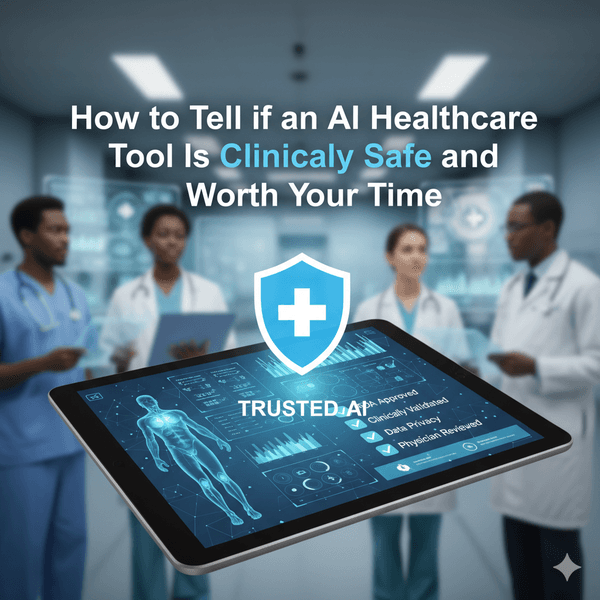Artificial intelligence has moved from conference buzzword to everyday clinical reality. New tools appear almost weekly — each promising faster documentation, better accuracy, or fewer administrative headaches.
But for every reliable product, others that raise questions about data security, accuracy, or patient safety.
So before you integrate an AI tool into your workflow, it’s worth asking: How do I know it’s actually safe and clinically sound?
At Doxiverse, we believe responsible adoption begins with clarity. Here’s a simple framework every clinician or practice leader can use.
1. Start with Transparency
If a company can’t clearly explain what their tool does or how it was built, that’s your first red flag.
Look for:
- Who developed it: Was it a healthcare-focused company or a general tech startup repurposing existing AI?
- Intended use: Does it claim to assist clinicians, or does it make diagnostic decisions on its own?
- Training data: Has the company disclosed whether the model was trained on real clinical data — and if so, was it de-identified and ethically sourced?
A transparent company will share its mission, data practices, and model limitations openly.
2. Confirm Regulatory and Compliance Status
Any tool that touches patient information must meet privacy and regulatory standards.
Ask these questions:
- HIPAA compliance: Does the platform handle Protected Health Information securely?
- FDA clearance: For diagnostic or decision-support software, has it been cleared or approved?
- Additional certifications: SOC 2, GDPR, or ISO 27001 indicate broader data-security maturity.
Be cautious of vague statements like “We follow HIPAA principles.” True compliance involves formal audits and documentation.
3. Demand Evidence, Not Marketing
A credible AI healthcare product should have validation data behind it — ideally peer-reviewed or publicly available.
Look for:
- Published studies or clinical trial data.
- Real-world performance metrics (accuracy, sensitivity, false-positive rates).
- Details on independent evaluations or pilot results.
If a company provides only testimonials or generic “AI-powered” claims, pause. Medicine advances on evidence, not slogans.
4. Evaluate Workflow Fit
Even the safest AI tool fails if it disrupts care delivery.
Consider:
- Integration: Does it connect with your EHR or imaging system?
- Time impact: Does it save time or add extra clicks?
- Ease of training: Can your team adopt it without steep learning curves?
Tools that quietly enhance existing workflows succeed far more than those that require clinicians to change how they practice.
5. Examine Security and Privacy Measures
Patient trust depends on protecting their data. Before signing up, review how the tool manages:
- Data storage: Where are servers located?
- Encryption: Is data encrypted in transit and at rest?
- Access control: Who can view patient information within the platform?
Strong tools provide clear answers and written documentation — not generic assurances.
6. Learn from Early Adopters
Clinician feedback can reveal what brochures never do. Ask peers, check forums, or read reviews on Doxiverse, where users share real-world experiences about performance, support, and reliability.
Patterns of consistent positive feedback — especially about accuracy, support responsiveness, and integration — signal a product built for longevity.
7. The Doxiverse Review Framework
Every AI tool featured on Doxiverse is reviewed using four guiding criteria:
- Clinical Relevance: Does it genuinely improve workflow or outcomes?
- Evidence & Compliance: Is it transparent, validated, and privacy-safe?
- User Experience: Is it practical for daily clinical use?
- Transparency & Updates: Does the vendor disclose updates and model improvements?
We designed this framework so busy clinicians can quickly assess reliability without navigating endless technical details.
8. Smarter Adoption, Safer Practice
AI in healthcare isn’t something to fear — it’s something to understand.
Clinicians who approach it thoughtfully will gain the most benefit while avoiding the noise.
Before you integrate any new system, remember this checklist:
Be skeptical, verify claims, prioritize safety, and look for transparency.
And if you’d like to save time researching, Doxiverse is here to help — curating trusted AI tools and sharing honest insights from across the clinical community.

Top comments (0)
Please login or create an account to leave a comment.